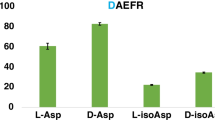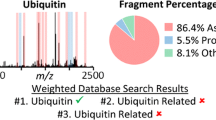Abstract
Evaluation of post-translational modifications of protein molecules is important for both basic and applied biomedical research. Mass spectrometric quantitative studies of modifications, which do not change the mass of the protein, such as isomerization of aspartic acid, do not necessarily require the use of isotope-labelled standards. However, the accurate solution of this problem requires a deep understanding of the relationship between the mole fractions of the isomers and the peak intensities in the mass spectra. In previous studies on the isomerization of aspartic acid in short beta-amyloid fragments, it has been shown that calibration curves used for such quantitative studies often have a non-linear form. The reason for the deviation in the shape of the calibration curves from linearity has not yet been established. Here, we propose an explanation for this phenomenon based on a probabilistic model of the fragmentation process and present a general approach for the selection of fragments that can be used for quantitative studies of the degree of isomerization.

Graphical Abstract






Similar content being viewed by others
References
Tsvetkov PO, Popov IA, Nikolaev EN, Archakov AI, Makarov AA, Kozin SA. Isomerization of the Asp7 residue results in zinc-induced oligomerization of Alzheimer’s disease amyloid β(1–16) peptide. Chem Bio Chem. 2008;9(10):1564–7.
Zirah S, Kozin SA, Mazur AK, Blond A, Cheminant M, Ségalas-Milazzo I, et al. J Biol Chem. 2006;281(4):2151–61.
Kozin SA, Mitkevich VA, Makarov AA. Amyloid-β containing isoaspartate 7 as potential biomarker and drug target in Alzheimer’s disease. Mendeleev Commun. 2016;26(4):269–75.
Moro ML, Phillips AS, Gaimster K, Paul C, Mudher A, Nicoll JAR, et al. Pyroglutamate and isoaspartate modified amyloid-beta in ageing and Alzheimer’s disease. Acta Neuropathol Commun. 2018;6(1):3.
Perez-Hurtado P, O’Connor PB. Differentiation of isomeric amino acid residues in proteins and peptides using mass spectrometry. Mass Spectrom Rev. 2012;31(6):609–25.
Jia C, Lietz CB, Yu Q, Li L. Site-specific characterization of D-amino acid containing peptide epimers by ion mobility spectrometry. Anal Chem. 2014;86(6):2972–81.
Jeanne Dit Fouque K, Garabedian A, Porter J, Baird M, Pang X, Williams TD, et al. Fast and effective ion mobility–mass spectrometry separation of D-amino-acid-containing peptides. Anal Chem. 2017;89(21):11787–94.
Zheng X, Deng L, Baker ES, Ibrahim YM, Petyuk VA, Smith RD. Distinguishing D- and L-aspartic and isoaspartic acids in amyloid β peptides with ultrahigh resolution ion mobility spectrometry. Chem Commun. 2017;53(56):7913–6.
Yang H, Zubarev RA. Mass spectrometric analysis of asparagine deamidation and aspartate isomerization in polypeptides. Electrophoresis. 2010;31(11):1764–72.
O’Connor PB, Cournoyer JJ, Pitteri SJ, Chrisman PA, Mcluckey SA. Differentiation of aspartic and isoaspartic acids using electron transfer dissociation. J Am Soc Mass Spectrom. 2006;17(1):15–9.
Pekov S, Indeykina M, Popov I, Kononikhin A, Bocharov K, Kozin S, et al. Application of MALDI-TOF/TOF-MS for relative quantitation of α- and β-Asp7 isoforms of amyloid-β peptide. Eur J Mass Spectrom. 2018;24(1):141–4.
Degraan-Weber N, Zhang J, Reilly JP. Distinguishing aspartic and isoaspartic acids in peptides by several mass spectrometric fragmentation methods. J Am Soc Mass Spectrom. 2016;27(12):2041–53.
Hamidane HB, Vorobyev A, Larregola M, Lukaszuk A, Tourwé D, Lavielle S, et al. Radical stability directs electron capture and transfer dissociation of β-amino acids in peptides. Chem A Eur J. 2010;16(15):4612–22.
Yamazaki Y, Fujii N, Sadakane Y, Fujii N. Differentiation and semiquantitative analysis of an isoaspartic acid in human α-crystallin by postsource decay in a curved field reflectron. Anal Chem. 2010;82(15):6384–94.
Ayrton ST, Chen X, Bain RM, Pulliam CJ, Achma-Towicz M, Flick TG, et al. Gas phase ion chemistry to determine isoaspartate in a peptide backbone. J Am Soc Mass Spectrom. 2018;29(7):1339–44.
Riggs DL, Gomez SV, Julian RR. Sequence and solution effects on the prevalence of D-isomers produced by deamidation. ACS Chem Biol. 2017;12(11):2875–82.
Tao Y, Julian R. Identification of amino acid epimerization and isomerization in crystallin proteins by tandem LC-MS. Anal Chem. 2014;86(19):9733–41.
Cournoyer JJ, Lin C, Bowman MJ, O’Connor PB. Quantitating the relative abundance of isoaspartyl residues in deamidated proteins by electron capture dissociation. J Am Soc Mass Spectrom. 2007;18(1):48–56.
Indeykina MI, Popov IA, Kozin SA, Kononikhin AS, Kharybin ON, Tsvetkov PO, et al. Capabilities of MS for analytical quantitative determination of the ratio of α- And βasp7 isoforms of the amyloid-β peptide in binary mixtures. Anal Chem. 2011;83(8):3205–10.
Pekov SI, Ivanov DG, Bugrova AE, Indeykina MI, Zakharova NV, Popov IA, et al. Evaluation of MALDI-TOF/TOF mass spectrometry approach for quantitative determination of aspartate residue isomerization in the amyloid-β peptide. J Am Soc Mass Spectrom. 2019;30:1325–9.
Suckau D, Resemann A, Schuerenberg M, et al. A novel MALDI LIFT-TOF/TOF mass spectrometer for proteomics. Anal Bioanal Chem. 2003;376:952.
Paizs B, Suhai S. Fragmentation pathways of protonated peptides. Mass Spectrom Rev. 2005;24(4):508–48.
Zagorski MG, Barrow CJ. NMR studies of amyloid .beta.-peptides: proton assignments, secondary structure, and mechanism of an alpha-helix to beta-sheet conversion for a homologous, 28-residue, N-terminal fragment. Biochemistry. 1992;31(24):5621–31.
Pettersen EF, Goddard TD, Huang CC, Couch GS, Greenblatt DM, Meng EC, et al. UCSF Chimera--a visualization system for exploratory research and analysis. J Comput Chem. 2004;25(13):1605–12.
Funding
The research was supported by the Russian Scientific Foundation Grant No. 16-14-00181.
Author information
Authors and Affiliations
Corresponding author
Ethics declarations
Conflict of interest
There authors declare that they have no conflicts of interest.
Additional information
Publisher’s note
Springer Nature remains neutral with regard to jurisdictional claims in published maps and institutional affiliations.
Electronic supplementary material
ESM 1
(PDF 635 KB)
Rights and permissions
About this article
Cite this article
Ivanov, D.G., Indeykina, M.I., Pekov, S.I. et al. Probabilistic model applied to ion abundances in product-ion spectra: quantitative analysis of aspartic acid isomerization in peptides. Anal Bioanal Chem 411, 7783–7789 (2019). https://doi.org/10.1007/s00216-019-02174-6
Received:
Revised:
Accepted:
Published:
Issue Date:
DOI: https://doi.org/10.1007/s00216-019-02174-6




